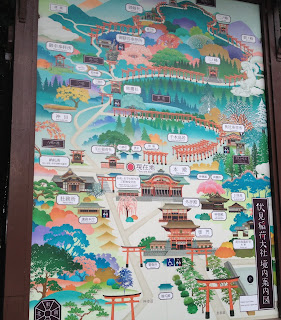Jeff Siger's Saturday post this week left me angry and deeply in need of hope. (If you haven't read it, click here. I'll wait.)
Back? Okay, then.
Long before lifejackets (good or evil), long before airplanes, and long before the first computer reduced the size of our world to the shifting of pixels, the Japanese knew where to go when their spirits were ruffled or in distress, and when they needed help with everything from life-giving harvests to help with a troubled birth.
In Japan, when you needed help, you went to a shrine--and one of the finest, most peace-giving shrines I know lies on a mountain south of Kyoto: Fushimi Inari Taisha (in English, Fushimi Inari Shrine.)
Like most Shinto holy places, the entrance to Fushimi Inari is marked with a torii, but Inari merits no ordinary gate:
 |
| That's one big gate. |
Big surprise...the god(dess) of fertility gets around.
 |
| The primary shrine at the base of Mount Inari |
The main shrine complex dates to 1499 (though the shrine itself was founded in 711, and moved to its current location at the base of Mount Inari in 816). Here, worshippers can leave offerings and offer prayers before the largest of the shrine's many altars...
 |
| Each plaque represents a prayer, as does every paper on every string. |
...and purchase prayer amulets, which are hung in rows along with prayer papers (many of those colorful strings are actually folded origami cranes, each folded while reciting a prayer).
 |
| Many papers, many amulets, many prayers. |
Here, you can also purchase a fortune, concealed in a strip of bamboo or a small clay fox (according to Shinto beliefs, the fox is Inari's messenger). Good fortunes, you take with you. Bad ones, you tie to these wires, and Inari takes the misfortune away.
 |
| Wouldn't it be nice if we could leave all misfortune here? |
The lower shrine area is also home to one of Japan's best-preserved medieval stages for No (also written "Noh") drama--a stage which actually appears in my next mystery novel...
 |
| No(h) play today, sorry. |
After leaving the base of the shrine, visitors pass up several flights of stairs to reach the start of the gate-lined path that leads to the top of the mountain.
 |
| You are...not nearly close enough to the top. |
Thousands of gates line the path, nestled close together near the bottom:
 |
| The donors' names are inscribed on the back side of each gate. |
and spreading out substantially more as you climb.
 |
| No, I didn't count them - but apparently there are over 10,000. |
Most visitors climb only partway up, to the first of the major sub-shrines that act as way stations on the pilgrim path to the holiest place on the mountain, the summit shrine.
 |
| The summit of Mount Inari. |
The journey from base to summit takes 2.5-4 hours, depending on whether you stop for tea and snacks at one (or more) of the sub-shrines and also on your physical condition. I stopped for lunch at a sub-shrine with a restaurant that featured a Fushimi Inari specialty: inari sushi.
 |
| Worth the walk. |
For those not in the know: Inari sushi is sweetened tofu skin wrapped around a mixture of sushi rice and black sesame seeds. (And regardless of your opinion of tofu, it's delicious.)
The restaurant also had an amazing view:
 |
| On the side you can't see...a bunch of tired people. |
A couple of hours (and a couple of rain showers) later, I reached the top:
 |
| I take terrible selfies, but...I needed proof. |
The descent took only half as long as the upward part of the journey, but I took my time--I didn't want the magical time on the mountain to end.
 |
| Would you want to leave? |
To this day, Fushimi Inari ranks among the most peaceful, sacred places I have ever been, and I doubt I'll find many that can compare. When life seems too frustrating to bear, I turn to my pictures and memories, and they remind me that there are places in this world where peace still reigns...
 |
| Traditionally, the fox guardians hold either a ball or a storehouse key in their mouths. |
... under the faithful, watchful eyes of Inari's guardian foxes.
















Japan is one the most paradoxical places I've ever visited. One the one hand, the latent violence; on the other the ethereal Fushimi Inari Taisha and thousands of other serene places. I love Japan, but it is always a conundrum to me.
ReplyDeleteAhh, the lovely dichotomy - it's one of the things that drew me to Japan in the first place (back in my college years). The juxtaposition of insane beauty, with violence just beneath the surface, mixed together in an insanely complex web of etiquette, history, and political intrigue. Is there a better setting for a novelist? (Clearly, I think not...)
DeleteA beautiful, peaceful trip, Susan, thanks for taking us along!
ReplyDeleteThank you for going with me, Everett! I'm always glad to share a little beauty when I can.
DeleteYou are literally the hiking ambassador for so much that is beauty in Japan! Thank you for sharing, Susan. Now, if you'll excuse me, I'm going to look through your photos again to reassure myself that indeed there are places where peace still reigns.
ReplyDeleteThanks Jeff! After your important but infuriating post yesterday, I needed a psychological palate cleanser...and I hoped this might fit the bill.
Delete